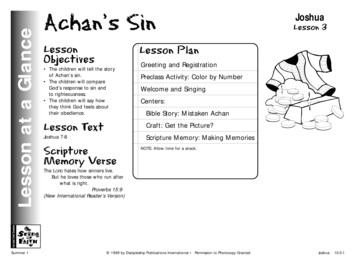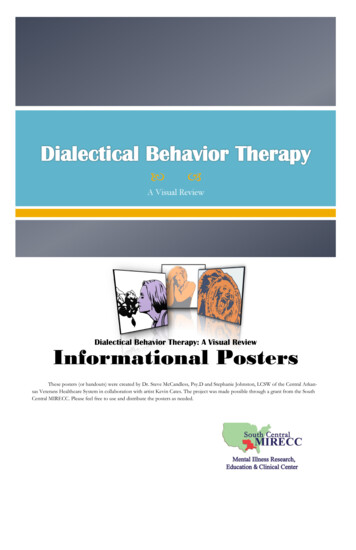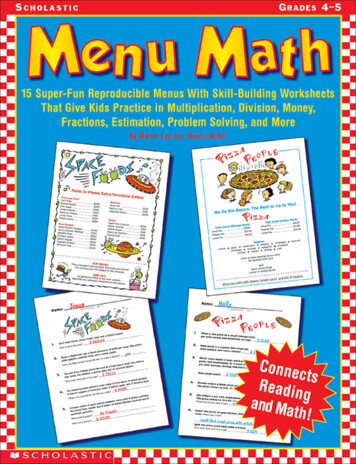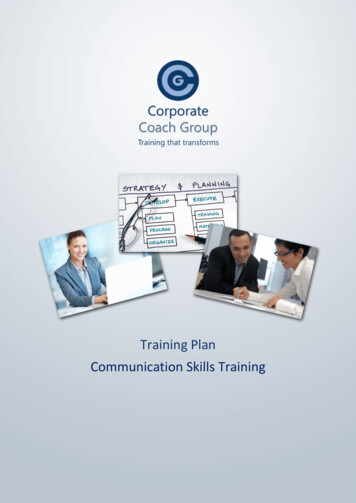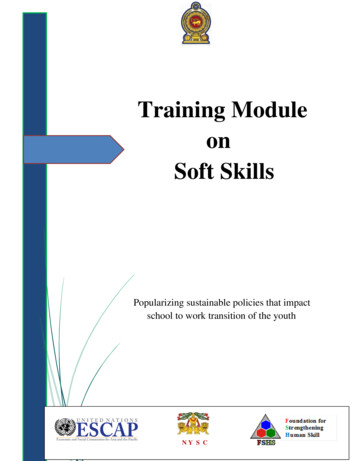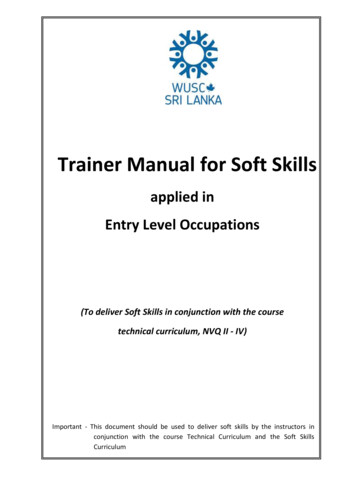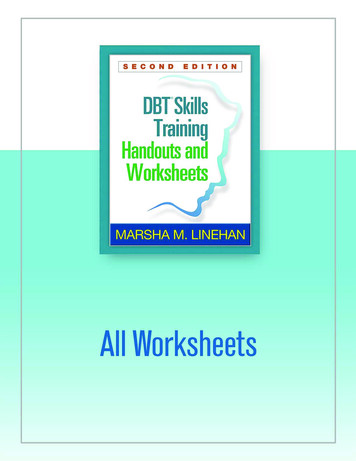
Transcription
2015 Marsha M. LinehanPublished by The Guilford PressA Division of Guilford Publications, Inc.370 Seventh Avenue, Suite 1200, New York, NY 10001www.guilford.comAll rights reservedLIMITED DUPLICATION LICENSEThe publisher grants to individual purchasers of DBT Skills Training Handouts and Worksheets,Second Edition, and DBT Skills Training Manual, Second Edition, nonassignable permission toreproduce these materials. This license is limited to you, the individual purchaser, for personal use oruse with individual clients. This license does not grant the right to reproduce these materials for resale,redistribution, electronic display, or any other purposes (including but not limited to books, pamphlets,articles, video- or audiotapes, blogs, file-sharing sites, Internet or intranet sites, and handouts orslides for lectures, workshops, or webinars, whether or not a fee is charged). Permission to reproducethese materials for these and any other purposes must be obtained in writing from the PermissionsDepartment of Guilford Publications.The author has checked with sources believed to be reliable in her efforts to provide information thatis complete and generally in accord with the standards of practice that are accepted at the time ofpublication. However, in view of the possibility of human error or changes in behavioral, mental health,or medical sciences, neither the author, nor the editor and publisher, nor any other party who has beeninvolved in the preparation or publication of this work warrants that the information contained hereinis in every respect accurate or complete, and they are not responsible for any errors or omissions or theresults obtained from the use of such information. Readers are encouraged to confirm the informationcontained in this document with other sources.DBT is a registered trademark of Marsha M. Linehan.ii
CONTENTSGeneral Skills: Orientation and Analyzing BehaviorGeneral WorksheetsOrientation WorksheetGeneral Worksheet 1: Pros and Cons of Using SkillsWorksheets for Analyzing BehaviorGeneral Worksheet 2: Chain Analysis of Problem BehaviorGeneral Worksheet 2a: Example—Chain Analysis of Problem BehaviorGeneral Worksheet 3: Missing-Links AnalysisMindfulness SkillsMindfulness WorksheetsWorksheets for Core Mindfulness SkillsMindfulness Worksheet 1: Pros and Cons of Practicing MindfulnessMindfulness Worksheet 2: Mindfulness Core Skills PracticeMindfulness Worksheet 2a: Mindfulness Core Skills PracticeMindfulness Worksheet 2b: Mindfulness Core Skills PracticeMindfulness Worksheet 2c: Mindfulness Core Skills CalendarMindfulness Worksheet 3: Wise Mind PracticeMindfulness Worksheet 4: Mindfulness “What” Skills—Observing, Describing, ParticipatingMindfulness Worksheet 4a: Observing, Describing, Participating ChecklistMindfulness Worksheet 4b: Observing, Describing, Participating CalendarMindfulness Worksheet 5: Mindfulness “How” Skills—Nonjudgmentalness, One- Mindfulness, EffectivenessMindfulness Worksheet 5a: Nonjudgmentalness, One- Mindfulness, EffectivenessChecklistMindfulness Worksheet 5b: Nonjudgmentalness, One- Mindfulness, EffectivenessCalendarMindfulness Worksheet 5c: Nonjudgmentalness CalendarWorksheets for Other Perspectives on Mindfulness SkillsMindfulness Worksheet 6: Loving KindnessMindfulness Worksheet 7: Balancing Being Mind with Doing MindMindfulness Worksheet 7a: Mindfulness of Being and Doing CalendarMindfulness Worksheet 8: Mindfulness of Pleasant Events CalendarMindfulness Worksheet 9: Mindfulness of Unpleasant Events CalendarMindfulness Worksheet 10: Walking the Middle Path to Wise MindMindfulness Worksheet 10a: Analyzing Yourself on the Middle PathMindfulness Worksheet 10b: Walking the Middle Path Calendariii
Interpersonal Effectiveness SkillsInterpersonal Effectiveness WorksheetsWorksheets for Goals and Factors That InterfereInterpersonal Effectiveness Worksheet 1: Pros and Cons of Using InterpersonalEffectiveness SkillsInterpersonal Effectiveness Worksheet 2: Challenging Myths in the Wayof Obtaining ObjectivesWorksheets for Obtaining Objectives SkillfullyInterpersonal Effectiveness Worksheet 3: Clarifying Priorities in InterpersonalSituationsInterpersonal Effectiveness Worksheet 4: Writing Out Interpersonal EffectivenessScriptsInterpersonal Effectiveness Worksheet 5: Tracking Interpersonal EffectivenessSkills UseInterpersonal Effectiveness Worksheet 6: The Dime Game—Figuring Out HowStrongly to Ask or Say NoInterpersonal Effectiveness Worksheet 7: Troubleshooting InterpersonalEffectiveness SkillsWorksheets for Building Relationships and Ending Destructive OnesInterpersonal Effectiveness Worksheet 8: Finding and Getting People to Like YouInterpersonal Effectiveness Worksheet 9: Mindfulness of OthersInterpersonal Effectiveness Worksheet 10: Ending RelationshipsWorksheets for Walking the Middle PathInterpersonal Effectiveness Worksheet 11: Practicing DialecticsInterpersonal Effectiveness Worksheet 11a: Dialectics ChecklistInterpersonal Effectiveness Worksheet 11b: Noticing When You’re Not DialecticalInterpersonal Effectiveness Worksheet 12: Validating OthersInterpersonal Effectiveness Worksheet 13: Self- Validationand Self- RespectInterpersonal Effectiveness Worksheet 14: Changing Behavior with ReinforcementInterpersonal Effectiveness Worksheet 15: Changing Behavior by Extinguishing orPunishing ItEmotion Regulation SkillsEmotion Regulation WorksheetsEmotion Regulation Worksheet 1: Pros and Cons of Changing EmotionsWorksheets for Understanding and Naming EmotionsEmotion Regulation Worksheet 2: Figuring Out What My Emotions Are Doingfor Meiv
Emotion Regulation Worksheet 2a: Example—Figuring Out What My EmotionsAre Doing for MeEmotion Regulation Worksheet 2b: Emotion DiaryEmotion Regulation Worksheet 2c: Example—Emotion DiaryEmotion Regulation Worksheet 3: Myths about EmotionsEmotion Regulation Worksheet 4: Observing and Describing EmotionsEmotion Regulation Worksheet 4a: Observing and Describing EmotionsWorksheets for Changing Emotional ResponsesEmotion Regulation Worksheet 5: Check the FactsEmotion Regulation Worksheet 6: Figuring Out How to Change UnwantedEmotionsEmotion Regulation Worksheet 7: Opposite Action to Change EmotionsEmotion Regulation Worksheet 8: Problem Solving to Change EmotionsWorksheets for Reducing Vulnerability to Emotion MindEmotion Regulation Worksheet 9: Steps for Reducing Vulnerability to EmotionMindEmotion Regulation Worksheet 10: Pleasant Events DiaryEmotion Regulation Worksheet 11: Getting from Values to Specific Action StepsEmotion Regulation Worksheet 11a: Getting from Values to Specific Action StepsEmotion Regulation Worksheet 11b: Diary of Daily Actions on Valuesand PrioritiesEmotion Regulation Worksheet 12: Build Mastery and Cope AheadEmotion Regulation Worksheet 13: Putting ABC Skills TogetherDay by DayEmotion Regulation Worksheet 14: Practicing PLEASE SkillsEmotion Regulation Worksheet 14a: Target Nightmare Experience FormEmotion Regulation Worksheet 14b: Sleep Hygiene Practice SheetWorksheets for Managing Really Difficult EmotionsEmotion Regulation Worksheet 15: Mindfulness of Current EmotionsEmotion Regulation Worksheet 16: Troubleshooting Emotion Regulation SkillsDistress Tolerance SkillsDistress Tolerance WorksheetsWorksheets for Crisis Survival SkillsDistress Tolerance Worksheet 1: Crisis Survival SkillsDistress Tolerance Worksheet 1a: Crisis Survival SkillsDistress Tolerance Worksheet 1b: Crisis Survival SkillsDistress Tolerance Worksheet 2: Practicing the STOP SkillDistress Tolerance Worksheet 2a: Practicing the STOP Skillv
Distress Tolerance Worksheet 3: Pros and Cons of Acting on Crisis UrgesDistress Tolerance Worksheet 3a: Pros and Cons of Acting on Crisis UrgesDistress Tolerance Worksheet 4: Changing Body Chemistry with TIP SkillsDistress Tolerance Worksheet 4a: Paired Muscle RelaxationDistress Tolerance Worksheet 4b: Effective Rethinking and Paired RelaxationDistress Tolerance Worksheet 5: Distracting with Wise Mind ACCEPTSDistress Tolerance Worksheet 5a: Distracting with Wise Mind ACCEPTSDistress Tolerance Worksheet 5b: Distracting with Wise Mind ACCEPTSDistress Tolerance Worksheet 6: Self- SoothingDistress Tolerance Worksheet 6a: Self- SoothingDistress Tolerance Worksheet 6b: Self- SoothingDistress Tolerance Worksheet 6c: Body Scan Meditation, Step by StepDistress Tolerance Worksheet 7: IMPROVE the MomentDistress Tolerance Worksheet 7a: IMPROVE the MomentDistress Tolerance Worksheet 7b: IMPROVE the MomentWorksheets for Reality Acceptance SkillsDistress Tolerance Worksheet 8: Reality Acceptance SkillsDistress Tolerance Worksheet 8a: Reality Acceptance SkillsDistress Tolerance Worksheet 8b: Reality Acceptance SkillsDistress Tolerance Worksheet 9: Radical AcceptanceDistress Tolerance Worksheet 9a: Practicing Radical AcceptanceDistress Tolerance Worksheet 10: Turning the Mind, Willingness, WillfulnessDistress Tolerance Worksheet 11: Half- Smiling and Willing HandsDistress Tolerance Worksheet 11a: Practicing Half- Smiling and Willing HandsDistress Tolerance Worksheet 12: Mindfulness of Current ThoughtsDistress Tolerance Worksheet 12a: Practicing Mindfulness of ThoughtsWorksheets for Skills When the Crisis Is AddictionDistress Tolerance Worksheet 13: Skills When the Crisis Is AddictionDistress Tolerance Worksheet 14: Planning for Dialectical AbstinenceDistress Tolerance Worksheet 15: From Clean Mind to Clear MindDistress Tolerance Worksheet 16: Reinforcing Nonaddictive BehaviorsDistress Tolerance Worksheet 17: Burning Bridges and Building New OnesDistress Tolerance Worksheet 18: Practicing Alternate Rebellion and AdaptiveDenialvi
General WorksheetsOrientation Worksheet
General Worksheet 1(General Handout 1 )9.p;Pros and Cons of Using SkillsDue Date: Name: Week Starting:Use this worksheet to figure out the advantages and disadvantages to you of using skills (i.e., actingskillfully) to reach your goals. The idea here is to figure out what is the most effective way for you toget what you want in life. Remember, this is about your goals, not someone else’s goals.Describe the situation or problem:Describe your goal in this situation:Make a list of the Pros and Cons of practicing your skills in this situation.Make another list of the Pros and Cons for not practicing your skills or of not practicing themcompletely.Check the facts to be sure that you are correct in your assessment of advantages anddisadvantages.ConsProsWrite on the back if you need more space.Practicing SkillsNot Practicing SkillsPracticing SkillsNot Practicing SkillsWhat did you decide to do in this situation?Is this the best decision (in Wise Mind)?From DBT Skills Training Handouts and Worksheets, Second Edition, by Marsha M. Linehan. Copyright 2015 by Marsha M. Linehan. Permission to photocopy this worksheet is granted to purchasers of DBT Skills Training Handouts and Worksheets, Second Edition, and DBT SkillsTraining Manual, Second Edition, for personal use and use with individual clients only. (See page ii of this packet for details.)
Worksheets for Analyzing Behavior
General Worksheet 2(p. 1 of 4)(General Handouts 7, 7a )12–02. pp;Chain Analysis of Problem BehaviorDue Date: Name: � Date:PROBLEM BEHAVIORVULNERABILITYPROMPTING EVENTLINKSCONSEQUENCES1. What exactly is the major problem behavior that I am analyzing?2. What prompting event in the environment started me on the chain to my problembehavior? Include what happened right before the urge or thought came into mymind.Day prompting event occurred:3. Describe what things in myself and in my environment made me vulnerable.Day the events making me vulnerable started:(continued on next page)From DBT Skills Training Handouts and Worksheets, Second Edition, by Marsha M. Linehan. Copyright 2015 by Marsha M. Linehan. Permission to photocopy this worksheet is granted to purchasers of DBT Skills Training Handouts and Worksheets, Second Edition, and DBT SkillsTraining Manual, Second Edition, for personal use and use with individual clients only. (See page ii of this packet for details.)
General Worksheet 2(p. 2 of 4)Links in the chain of events: Behaviors (Actions, Body sensations,Cognitions/Thoughts, Feelings) and Events (in the environment)Possible Types of LinksA. ActionsB. Body sensationsC. Cognitions/thoughtsE. EventsF. Feelings4. List the chain of events (specificbehaviors and environmental events thatactually did happen). Use the ABC-EF listabove.6. List new, more skillful behaviors toreplace ineffective behaviors. Use theABC-EF th.7th.7th.8th.8th.9th.9th.(continued on next page)
General Worksheet 2(p. 3 of 4)Links in the chain of events: Behaviors (Actions, Body sensations,Cognitions/Thoughts, Feelings) and Events (in the environment)Possible Types of LinksA. ActionsB. Body sensationsC. Cognitions/thoughtsE. EventsF. Feelings4. List the chain of events (specificbehaviors and environmental events thatactually did happen). Use the ABC-EF listabove.6. List new, more skillful behaviors toreplace ineffective behaviors. Use theABC-EF 14th.15th.15th.16th.16th.17th.17th.(continued on next page)
General Worksheet 2(p. 4 of 4)5. What exactly were the consequences in the environment?And in myself?What harm did my problem behavior cause?7. Prevention plans:Ways to reduce my vulnerability in the future:Ways to prevent precipitating event from happening again:8. Plans to repair, correct, and overcorrect the harm:
General Worksheet 2a(p. 1 of 3)(General Handouts 7, 7a )12–02. pp;Example: Chain Analysis of Problem BehaviorDue Date: Name: � Date:Problem Behavior:PROBLEM BEHAVIORVULNERABILITYPROMPTING EVENTLINKSCONSEQUENCES1. What exactly is the major problem behavior that I am analyzing?Drinking too much and driving drunk2. What prompting event in the environment started me on the chain to my problembehavior? Include what happened right before the urge or thought came into mymind.Day prompting event occurred: MondayMy sister from out of town called me and said she was not going to come visit me the nextweek like she had said she would, because her husband had an important business partyhe wanted her to attend with him.3. Describe what things in myself and in my environment made me vulnerable.Day the events making me vulnerable started: SundayMy boyfriend said he had to take a business trip sometime in the next month.(continued on next page)From DBT Skills Training Handouts and Worksheets, Second Edition, by Marsha M. Linehan. Copyright 2015 by Marsha M. Linehan. Permission to photocopy this worksheet is granted to purchasers of DBT Skills Training Handouts and Worksheets, Second Edition, and DBT SkillsTraining Manual, Second Edition, for personal use and use with individual clients only. (See page ii of this packet for details.)
General Worksheet 2A (p. 2 of 3)Links in the chain of events: Behaviors (Actions, Body sensations,Cognitions/Thoughts, Feelings) and Events (in the environment)Possible Types of LinksA. ActionsB. Body sensationsC. Cognitions/thoughtsE. EventsF. Feelings4. List the chain of events (specificbehaviors and environmental events thatactually did happen). Use the ABC-EF listabove.6. List new, more skillful behaviors toreplace ineffective behaviors. Use theABC-EF list.1st. I felt hurt and started sobbing on thephone with my sister and was angry withher.1st. Listen to why my sister could notcome.2nd. I thought, “I can’t stand it. No oneloves me.”3rd. I felt very ashamed once I hung upfrom talking to my sister.2nd. Remember that my sister and myboyfriend love me.3rd. Check the facts; is my sister going toreject me over this?4th. I thought “My life is useless; no onewill ever be here for me.”4th. Call my sister back and apologize forbeing angry (since I know she will validatehow I feel).5th. Tried watching TV, but nothing was onI liked.5th. Download a movie, work on a puzzle,or call a friend instead.6th. I started feeling agitated and thought,“I can’t stand this.”6th. Try my TIP skills to bring down arousal.7th. I decided to drink a glass of wine tofeel better, but ended up drinking two wholebottles.8th. Got in my car to drive to a late-nightconcert.9th. While I was bending down to pick up apiece of paper, car swerved. I was stoppedby a cop and taken in on a DUI.7th. Walk down the street and have adinner out, because I won’t drink too muchin public.8th. Call my boyfriend and ask him to comeover for a while.9th. Take a long bath, try TIP skills again;Keep checking the facts; remember theseemotions will pass; call my therapist for help.(continued on next page)
General Worksheet 2A (p. 3 of 3)5. What exactly were the consequences in the environment?Short-term: I had to spend the night in jail.Long-term: My boyfriend has less trust in me; my sister is upset about it.And in myself?Short-term: I am ashamed and furious with myself.Long-term: I will have to pay more for car insurance and may have trouble getting a job.What harm did my problem behavior cause?It hurt me by giving me a DUI record. My sister feels guilty because she upset me.7. Prevention plans:Ways to reduce my vulnerability in the future:Make plans for how to cope whenever my boyfriend is out of town.Ways to prevent precipitating event from happening again:I can’t keep the precipitating event from happening, so I need to practice coping ahead andhave plans for how to manage when I am at home alone.8. Plans to repair, correct, and overcorrect the harm:Apologize to my sister and reassure her that she has a perfect right to change her plans.Work with her to plan a new time for a visit. Ask if it would be easier for her if I came to visither.
General Worksheet 3(General Handout 8 )32.p;Missing-Links AnalysisTo understand missing effective behavior, do a missing-links analysis.Due Date: Name: � Date:Missing Behavior:Use this sheet to first figure out what got in the way of doing things you needed or hoped to do, orthings you agreed to do or others expected you to do. Then use that information to problem-solve,so that you will be more likely to do what is needed, hoped for, or expected next time.1. Did I know what effective behavior was needed or expected? Yes NoIf no to Question 1, what got in the way of knowing?Describe problem solving:STOP2. If yes to Question 1, was I willing to do what was needed? Yes NoIf no to Question 2, what got in the way of wanting to do what was needed?Describe problem solving:STOP3. If yes to Question 2, did the thought of doing what was needed or expected ever enter mymind? Yes NoIf no to Question 3, describe problem solving:4. If yes to Question 3, what got in the way of doing what was needed or expected right away?STOPDescribe problem solving:STOPFrom DBT Skills Training Handouts and Worksheets, Second Edition, by Marsha M. Linehan. Copyright 2015 by Marsha M. Linehan. Permission to photocopy this worksheet is granted to purchasers of DBT Skills Training Handouts and Worksheets, Second Edition, and DBT SkillsTraining Manual, Second Edition, for personal use and use with individual clients only. (See page ii of this packet for details.)
Mindfulness WorksheetsWorksheets for CoreMindfulness Skills
Mindfulness Worksheet 1(Mindfulness Handouts 1, 7)86, 54. pp;Pros and Cons of Practicing MindfulnessDue Date: Name: � Week Starting:Make a list of the pros and cons of practicing mindfulness skills.Make another list of the pros and cons of not practicing mindfulness skills.Check the facts to be sure that you are correct in your assessment of advantages anddisadvantages.Rate Willingness to Practice (0 None; 100 Very High) Before: After:Fill this worksheet out when you are: Trying to decide whether to work on becoming more mindful of the moments in your life. Feeling willful; saying no to letting go of emotion mind or extreme reasonable mind. Resisting observing the present moment, rather than escaping it or trying to control it. Resisting giving up your interpretations of others or yourself, rather than just describing. Resisting throwing yourself into the flow of the moment; wanting to stand on the outside. Feeling threatened whenever you think of letting go of judgments. Not in the mood for being effective instead of proving you are right.ConsProsWhen you are filling out this worksheet, think about these questions: Is a mindless life in your best interest (i.e., effective), or not in your best interest (i.e., ineffective)? Will refusing to go into Wise Mind solve a problem, or make a new problem for you? Is observing the moment without reacting to it immediately likely to increase your freedom, ordecrease it? Is being attached to your thoughts instead of the facts you can describe useful, or not? Is staying judgmental helping you change the things you want to change, or getting in the way? Is it more important to be effective, or to be right?Stay Mindless, Judgmental, IneffectivePractice MindfulnessStay Mindless, Judgmental, IneffectivePractice MindfulnessWhat did you decide to do?Is this the best decision (in Wise Mind)?List any and all wise things you did this week.From DBT Skills Training Handouts and Worksheets, Second Edition, by Marsha M. Linehan. Copyright 2015 by Marsha M. Linehan. Permission to photocopy this worksheet is granted to purchasers of DBT Skills Training Handouts and Worksheets, Second Edition, and DBT SkillsTraining Manual, Second Edition, for personal use and use with individual clients only. (See page ii of this packet for details.)
Mindfulness Worksheet 2(Mindfulness Handouts 2–5c )36–94. pp;Mindfulness Core Skills PracticeDue Date: Name: � Week Starting:Describe the situations that prompted you to practice mindfulness.Situation 1Situation (who, what, when, where): Wise Mind Observe Describe Participate Nonjudgmentally One- mindfully EffectivelyAt left, check the skills you used, and describe your use of them here.Describe experience of using the skill:Check if practicing this mindfulness skill has influenced any of the following, even a little bit:Reduced sufferingIncreased happinessIncreased ability to focusDecreased reactivityIncreased wisdomIncreased experiencing theIncreased connectionIncreased sense of personal validitypresentSituation 2Situation (who, what, when, where): Wise Mind Observe Describe Participate Nonjudgmentally One- mindfully EffectivelyAt left, check the skills you used, and describe your use of them here.Describe experience of using the skill:Check if practicing this mindfulness skill has influenced any of the following, even a little bit:Reduced sufferingIncreased happinessIncreased ability to focusDecreased reactivityIncreased wisdomIncreased experiencing theIncreased connectionIncreased sense of personal validitypresentList any and all wise things you did this week.From DBT Skills Training Handouts and Worksheets, Second Edition, by Marsha M. Linehan. Copyright 2015 by Marsha M. Linehan. Permission to photocopy this worksheet is granted to purchasers of DBT Skills Training Handouts and Worksheets, Second Edition, and DBT SkillsTraining Manual, Second Edition, for personal use and use with individual clients only. (See page ii of this packet for details.)
Mindfulness Worksheet 2a(Mindfulness Handouts 2–5c )36–94. pp;Mindfulness Core Skills PracticeDue Date: Name: � Week Starting:For each mindfulness skill, write down what you did during the week, and then rate the quality ofmindfulness you experienced during your practice.I could not focus my mindfor even 1 second; I wascompletely mindless and quit.I was able to focus mymind somewhat and stayin the present moment.I became centered in WiseMind and was free to let goand do what was needed.1234 5DayWise �� �� � �� �� �� �� �� �� �� �� � �� �� Mindfulness:Day:One- �� �� �� �� �� �� Mindfulness:List any and all wise things you did this week.From DBT Skills Training Handouts and Worksheets, Second Edition, by Marsha M. Linehan. Copyright 2015 by Marsha M. Linehan. Permission to photocopy this worksheet is granted to purchasers of DBT Skills Training Handouts and Worksheets, Second Edition, and DBT SkillsTraining Manual, Second Edition, for personal use and use with individual clients only. (See page ii of this packet for details.)
Mindfulness Worksheet 2b(Mindfulness Handouts 2–5c )36–94. pp;Mindfulness Core Skills PracticeDue Date: Name: � Week Starting:Practice each mindfulness skill twice, and describe your experience as follows:When did you practice thisskill, and what did you do topractice?What was going on thatprompted practicingmindfulness (if anything)?Wise One- mindfully:Effectively:Rate before/after skill useHow muchDegree oftime passed Degree offocusing being centeredwhen youwere doing my mind in Wise Mind(0–100)(0–100)this skill?////////////////////////////Conclusions or questionsabout this skills practiceList any and all wise things you did this week:Note. Adapted from an unpublished worksheet by Seth Axelrod, with his permission.From DBT Skills Training Handouts and Worksheets, Second Edition, by Marsha M. Linehan. Copyright 2015 by Marsha M. Linehan. Permission to photocopy this worksheet is granted to purchasers of DBTSkills Training Handouts and Worksheets, Second Edition, and DBT Skills Training Manual, Second Edition, for personal use and use with individual clients only. (See page ii of this packet for details.)
Mindfulness Worksheet 2c(p. 1 of 2)(Mindfulness Handouts 2–5c )36–94. pp;Mindfulness Core Skills CalendarDue Date: Name: � Week Starting:Check off skills to practice this week:Wise Mind Observing Describing Participating Nonjudgmentally One- mindfully EffectivelyWhile you are practicing skills, stay as aware and mindful as you can. Write it down later.Name(s) of skill(s)Example: ParticipatingHow did you practicethe skill?I went to a party and joinedin conversations with otherpeople.Describe your experience, including bodysensations, emotions, and thoughts whilepracticing the skillI felt a tight knot in my stomach, shallow breathing, dry mouth,anxiety that other people would not like me; later I enjoyed theconversation, smiled, noticed other people around me, andended up having a good time.What is your experience now,after using the skill?I feel amazed that I managed to dothis and felt good about myself. I amthinking I may be able to do this again.Monday:Tuesday:Wednesday:(continued on next page)From DBT Skills Training Handouts and Worksheets, Second Edition, by Marsha M. Linehan. Copyright 2015 by Marsha M. Linehan. Permission to photocopy this worksheet is granted to purchasers of DBTSkills Training Handouts and Worksheets, Second Edition, and DBT Skills Training Manual, Second Edition, for personal use and use with individual clients only. (See page ii of this packet for details.)
Mindfulness Worksheet 2C (p. 2 of 2)Name(s) of skill(s)How did you practicethe skill?Describe your experience, including bodysensations, emotions, and thoughts whilepracticing the skillWhat is your experience now,after using the skill?Thursday:Friday:Saturday:Sunday:List any and all wise things you did this week:
Mindfulness Worksheet 3(Mindfulness Handouts 3, 3a )1 5–05. pp;Wise Mind PracticeDue Date: Name: � Week Starting:Wise Mind Practice Exercise: Check off an exercise each time you do one. 1. Attended to my breath coming in and out, letting my attention settle into my center. 2. Imagined being a flake of stone on the lake. 3. Imagined walking down an inner spiral stairs. 4. Dropped into the pauses between inhaling and exhaling. 5. Breathed “wise” in, “mind” out. 6. Asked Wise Mind a question (breathing in) and listened for the answer (breathing out). 7. Asked myself, “Is this Wise Mind?” 8. Other (describe): 9. Other (describe):Describe the situation and how you practiced Wise Mind:How effective was the practice in helping you become centered in your Wise Mind?Not effective:I couldn’t do the skillfor even 1 minute. I gotdistracted or quit.Somewhat effective:I was able to practice Wise Mindand became somewhat centeredin my Wise Mind.Very effective:I became centered in WiseMind, and was free to dowhat needed to be �� 5Describe the situation and how you practiced Wise Mind:How effective was the practice in helping you become centered in your Wise Mind?Not effective:I couldn’t do the skillfor even 1 minute. I gotdistracted or quit.Somewhat effective:I was able to practice Wise Mindand became somewhat centeredin my Wise Mind.Very effective:I became centered in WiseMind, and was free to dowhat needed to be �� 5List any and all wise things you did this week:From DBT Skills Training Handouts and Worksheets, Second Edition, by Marsha M. Linehan. Copyright 2015 by Marsha M. Li
2.hat W PrOmPTinG evenT in the environment started me on the chain to my problem behavior? Include what happened ri GhT BefOre the urge or thought came into my mind. Day prompting event occurred: 3.cribe what things in myself and in
